

Can a hashtag change the fashion industry? Now in its second year, Fashion Revolution Day (FRD) is a hashtag campaign designed to keep the most vulnerable in the fashion supply chain in the public eye.
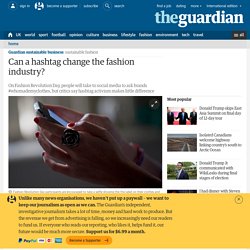
Held on the anniversary of the Rana Plaza factory collapse in Bangladesh, participants are encouraged to take a selfie showing the label on their clothes and ask the designer or brand #whomademyclothes. It’s an important cause, but can a hashtag campaign really bring meaningful change to the fashion industry? Ruth Stokes, author of The Armchair Activist’s Handbook, says if a campaign is able to raise awareness and reach people otherwise not engaged, then it has provided something of value. The challenge is translating that increased awareness into real-world practical actions, whether that means changing individual behaviors or the laws made by politicians. FRD has changed the hashtag this year to #whomademyclothes after Pixar took over #insideout in anticipation of the Disney animation film Inside Out.
#whocares #meaningfulchange. Can big brands catch up on sustainable fashion? Imagine a pair of trousers you could throw on the compost.
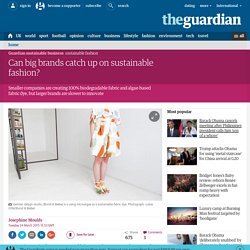
After years of use, they could decompose among the eggshells and tea bags to leave behind nothing but some fertile soil to help grow new raw materials. It takes the circular economy to a whole new level. This is the idea behind F-ABRIC, a range of materials developed by Swiss company Freitag. Until recently, Freitag’s only line of business was making bags out of old truck tarpaulins. While natural fibres like cotton will compost over time, synthetic fibres like polyester won’t, and natural fibres are often blended with synthetic. The fact that it is biodegradable does not make the fabric any less hard-wearing, says one of the founders, Daniel Freitag. Freitag is not the only company looking to microorganisms for inspiration. Essi Johanna Glomb, head of design at Blond & Bieber, says: “The colours for dyes are extremely toxic and really harm the people working with them and also nature.
The fashion hub is funded by H&M. How Sustainable Brands Are Turning Their Backs on Fast Fashion Trend. Every fall, fashionistas and students heading back to school rid themselves of their old, worn garments to gear up for the newest trends.
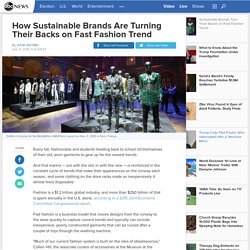
And that mantra — out with the old, in with the new — is reinforced in the constant cycle of trends that make their appearances on the runway each season, and some clothing on the store racks made so inexpensively it almost feels disposable. Fashion is a $1.2 trillion global industry, and more than $250 billion of that is spent annually in the U.S. alone, according to a 2015 Joint Economic Committee Congressional report.
Fast fashion is a business model that moves designs from the runway to the store quickly to capture current trends and typically can include inexpensive, poorly constructed garments that can be ruined after a couple of trips through the washing machine. The Dirty Fashion Industry The concept of pollution usually evokes images of coal power plants, oil spills, barren rain forests and plastic bottles clogging up the world's oceans. Why Is Every Big Designer Calling It Quits? Honey, you shrunk my bag! Why designer bags have gone micro. Hugo Boss Unveils First See Now, Buy Now Product. Hugo Boss Unveils First See Now, Buy Now Product (14 September 2016) At the label’s runway show in New York on Wednesday, Hugo Boss unveiled its first “see now, buy now” product — the Boss Bespoke Soft, a hand-painted leather bag inspired by David Hockey and available in four colours, which went on sale immediately after the runway show in select Boss stores worldwide and the brand’s website.
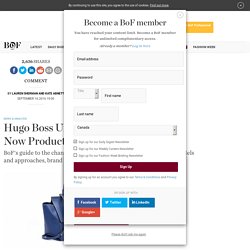
“I think now is the perfect time for Boss to offer new and exciting products to our consumers directly at the time they see it," Jason Wu, artistic director of Boss Womenswear, told BoF. "We are becoming even more retail driven and it makes sense to have a more customised experience in our stores and on hugoboss.com.” Michael Kors Takes A 'Hybrid' Approach to Fashion Immediacy (14 September 2016) Michael Kors Autumn/Winter 2016 | Source: Indigital. With Shoppable Runway Shows, Fashion Brands Court Millennials. NEW YORK, United States — In a world where younger consumers can summon a car or a meal at the click of a button, fashion houses are realising that their next generation of customers is not keen to wait six months for runway styles to hit store shelves.
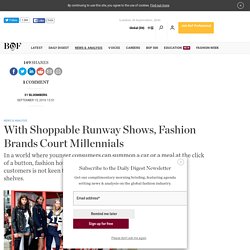
Millennials’ impatience has brands such as Tommy Hilfiger, Ralph Lauren Corp., Coach Inc., Michael Kors Holdings Ltd. and Tom Ford turning their New York Fashion Week runway shows into a so-called see-now-buy-now format. That is transforming the event — previously a showcase for industry insiders and items that will not appear until the following season — into a source of cold, hard, immediate sales. Global fashion brands — struggling with economic uncertainty, declining sales to tourists and the rise of fast-fashion and online rivals — are looking for ways to reinvigorate demand and generate buzz.
Live Streaming Tommy’s Fairground It also experimented with Facebook Messenger’s chatbot, which simulates conversations with customers.